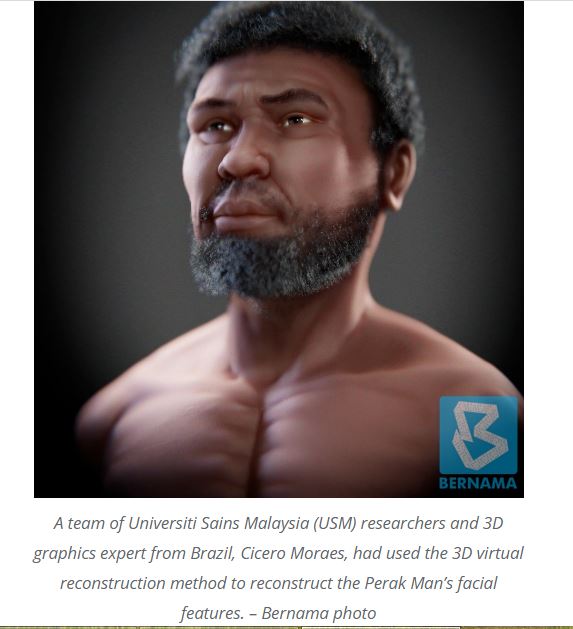End of February 2021 there was lots in the media that Perak Man now has a face. This is thanks to 3D modelling.
Perak Man, the most complete skeleton found in Southeast Asia, was uncovered at Gua Gunung Runtuh by a team of archaeologists led by Prof Datuk Dr Zuraina Majid in 1990. The excavation revealed a 10,000–11,000-year-old primary burial site of an adult human buried in the foetal position.
News reports :
FMT 24 Feb "10,000-year-old Perak Man has a face now"
Bernama 25 Feb “11,000-year-old Perak Man finally has a face”
Borneo Post 25 Feb “11,000-year-old Perak man finally has a face”
The Star 25 Feb “Perak Man now has a face, thanks to 3D modelling”.
“Perak Man – the oldest human skeleton discovered in Malaysia in 1991 – now has a face. A team at Universiti Sains Malaysia (USM) used virtual 3D modelling techniques to produce a facial representation of the centuries-old Perak Man. The team used 21st-century technologies to determine the cognitive capabilities of the 11,000-year-old Perak Man. It also determined that he had type A2 brachymesophalangia, a medical term which literally means “short fingers”. NST 26 Feb “The 11,000-year-old Perak Man gets a face”; this article shows a A 3D virtual reconstruction of Perak Man’s facial features.
Perak Man, the 11,000-year-old skeletal remains found 30 years ago in the Lenggong Valley, Perak, finally has a face. A team of Universiti Sains Malaysia (USM) researchers and 3D graphics expert from Brazil, Cicero Moraes, had used the 3D virtual reconstruction method to reconstruct the Perak Man’s facial features. A copy of the original skull was made using computed tomography (CT) and 3D printing.
 |
| FMT image |
And a YouTube video from Bernama, "INILAH WAJAH PERAK MAN" [this is the face of Perak Man]
A scientific paper: Abdullah JY, Saidin M, Rajion ZA, Hadi H, Mohamad N, Moraes C, Abdullah JM. Using 21st-century technologies to determine the cognitive capabilities of a 11,000-year-old Perak Man who had brachymesophalangia type A2. Malays J Med Sci. 2021;28(1):1–8. Link here .
*****

The only interesting thing about the paper was the facial reconstruction, but then the paper title claims to "Determine the Cognitive Capabilities" of the Perak Man, and does nothing of the sort.
ReplyDeleteThey were probably thinking of the amount of brain space in the skull!!!
ReplyDelete